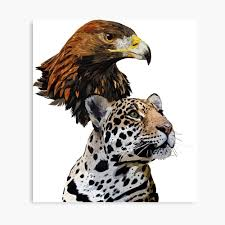Golden Eagles and Jaguars: A Comparative Study
Golden Eagles and Jaguars are two iconic species, each representing a different realm of nature. While the Golden Eagle reigns as a formidable avian predator in the skies, the Jaguar prowls the dense forests of the Americas with a stealthy grace. This comparison delves into their unique attributes, habitats, and roles in their respective ecosystems.
Table of Contents
Golden Eagles: Majestic Raptors of the Sky
Physical Characteristics
Golden Eagles (Aquila chrysaetos) are large birds of prey, renowned for their impressive wingspan, which can exceed 7 feet (2.2 meters). Their plumage is a striking mix of dark brown with golden hues on their nape. Equipped with powerful talons and a sharp, hooked beak, they are built for hunting.

Habitat and Range
Golden Eagles are primarily found in North America, Europe, and Asia. They inhabit a variety of landscapes, including mountainous regions, forests, and grasslands. They prefer open spaces where they can spot prey from a high vantage point.
Behavior and Diet
Golden Eagles are solitary hunters and use their exceptional vision to locate prey. Their diet mainly consists of small to medium-sized mammals, such as rabbits and squirrels, though they can also take down larger animals. They are known for their impressive aerial displays and territorial behavior.
Conservation Status
Currently, Golden Eagles are not considered endangered, though their populations are affected by habitat loss and human activities. Conservation efforts focus on protecting their habitats and ensuring they have adequate prey resources.

Jaguars: Stealthy Predators of the Jungle
Physical Characteristics
Jaguars (Panthera onca) are the largest cats in the Americas and the third-largest in the world. They are known for their robust build, powerful jaws, and distinctive coat pattern of yellowish fur with black rosettes. Their strong bite enables them to crush the shells of turtles and the skulls of their prey.
Habitat and Range
Jaguars are native to the rainforests of Central and South America, including the Amazon Basin. They prefer dense, tropical forests but can also be found in swamps and open savannas. Their habitat range is significantly impacted by deforestation and human encroachment.
Behavior and Diet
Unlike Golden Eagles, Jaguars are solitary and predominantly nocturnal. They are apex predators with a diet that includes a wide range of animals, from fish and birds to large mammals like deer and peccaries. Their hunting strategy involves ambush and stealth, taking advantage of their camouflage and the dense forest environment.
Conservation Status
Jaguars are listed as near-threatened, primarily due to habitat loss, poaching, and human-wildlife conflict. Conservation efforts are focused on protecting their habitats, curbing illegal hunting, and promoting coexistence with local human populations.

Ecological Impact
Golden Eagles
Golden Eagles play a crucial role in their ecosystems as top predators. They help control the populations of small mammals, which can otherwise become pests. Their presence indicates a healthy and balanced environment, as they require a diverse and abundant prey base.
Jaguars
Jaguars are also apex predators and play a vital role in maintaining the health of their ecosystems. By preying on a variety of species, they help regulate populations of other animals, preventing overgrazing and promoting biodiversity. Their decline can lead to cascading effects throughout their habitat.
Interaction with Humans
Golden Eagles
Golden Eagles have long been revered in various cultures and are often featured in mythology and heraldry. They are generally not a direct threat to humans but can occasionally prey on domestic animals. Conservation efforts often involve educating the public and implementing measures to reduce conflicts.
Jaguars
Jaguars have a more complex relationship with humans, as they are sometimes seen as a threat to livestock. This has led to conflicts and retaliatory killings. Conservation initiatives focus on creating wildlife corridors, reducing human-wildlife conflicts, and fostering local support for jaguar preservation.
indianfastearning.comhttp://indianfastearning.com
Conclusion
Both the Golden Eagle and the Jaguar are magnificent creatures that play essential roles in their ecosystems. While they inhabit different environments and exhibit distinct behaviors, their conservation is crucial for maintaining ecological balance. Efforts to protect these species not only ensure their survival but also contribute to the overall health of their habitats. Understanding and respecting these apex predators is vital for their continued existence and the well-being of the ecosystems they support.
www.utube.comhttp://www.utube.com
.







